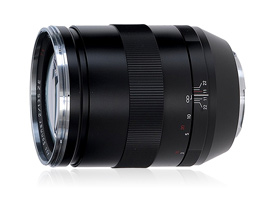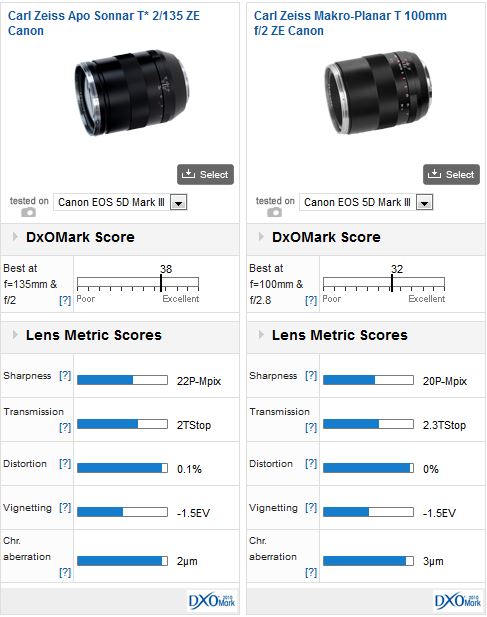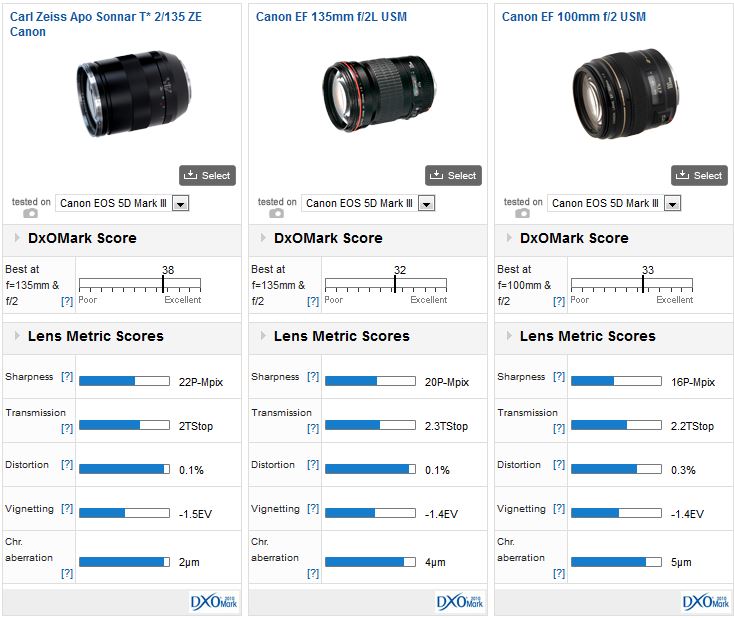Introduction
Following the withdrawal of Contax reflex cameras from the market, Zeiss, as lens developer to the system, re-established production in Japan by modifying some of the previous optical designs to fit Pentax, Nikon and Canon models. Today the line consists of 13 models with the Sonnar T* 2/135 (135mm f2.0) being the latest addition (not counting the new Otus range) though the firm now only supplies models in Canon or Nikon mount.
This newly designed high speed ‘Apo’ model has 11-elements arranged in 8-groups and features a ‘floating elements’ design for improved sharpness at close range. The Zeiss can focus down to 0.8m (2.62 ft), closer than most rivals of the same focal length. Designed specifically for the Canon EF mount, the ZE model features data contacts for electronic aperture control but, like others in the range, this lens has no autofocus capability – it’s manual focus only.
Lacking the aperture collar of the Nikon mount version, the ZE model looks very different externally and is marginally heavier at 2.05 lbs. (930g) and slightly longer overall at 5.12” (130mm). As a full frame model the $1,600 Zeiss Apo Sonnar T* 2/135 ZE is also a good choice for APS-C format DSLRs, where it’s the equivalent of a 216mm f2.
 |
 |
 |
 |
| Carl Zeiss Apo Sonnar T* 2/135 ZE Canon | 1600 | 38 | 22 |
| Sigma 85mm F1.4 EX DG HSM Canon | 969 | 35 | 20 |
| Canon EF 100mm f/2 USM | 440 | 33 | 16 |
| Carl Zeiss Makro-Planar T 100mm f/2 ZE Canon | 1840 | 32 | 20 |
| Canon EF 135mm f/2L USM | 1070 | 32 | 20 |
| Canon EF 85mm F1.2L USM | 1599 | 32 | 20 |
| Canon EF 85mm f/1.2L II USM | 1869 | 31 | 18 |
| Samyang 85mm f/1.4 Aspherique IF Canon | 285 | 30 | 15 |
| Canon EF 85mm f/1.8 USM | 379 | 28 | 18 |
| Canon EF 100mm f/2.8L Macro IS USM | 969 | 28 | 18 |
| Carl Zeiss Planar T 85mm f/1.4 ZE Canon | 1280 | 28 | 17 |
| Sigma 70mm F2.8 EX DG Macro Canon | 499 | 28 | 17 |
| Sigma 105mm F2.8 EX DG Macro Canon | 640 | 27 | 18 |
| Sigma 105mm F2.8 EX DG OS HSM Canon | 969 | 27 | 17 |
| Tamron SP AF 90mm F/2.8 Di MACRO Canon | 460 | 27 | 16 |
| Tamron SP 90mm F/2.8 Di MACRO 1:1 VC USD Canon | 718 | 25 | 16 |
| Canon EF 100mm f/2.8 Macro USM | 536 | 24 | 17 |
| Canon EF 135mm f/2.8 Soft Focus | 870 | 24 | 13 |
Carl Zeiss Apo Sonnar T* 2/135 ZE Canon lens performance: Ultra-high performance
The Zeiss Sonnar T* 2/135 achieves an excellent DxOMark score of 38 points putting in first place in our rankings of fixed focal length telephoto lenses on the Canon EOS 5D Mk III in our database. It also achieves the highest peak sharpness of 22P-Mpix, suggesting that it can out-resolve the 22-Mpix sensor in the EOS 5D Mk III. Sharpness is excellent across the frame at the initial aperture and levels improve slightly upon stopping down.
The optical quality is outstanding at any aperture up to f11 (where after diffraction effects occur). Vignetting at 1.5 Ev is at expected levels as is the very low distortion, however the control of lateral chromatic aberration is exceptional.
Transmission at 2T-stops is also remarkable.
Carl Zeiss Apo Sonnar T* 2/135 ZE Canon Versus Carl Zeiss Makro-Planar T 100mm f/2 ZE
The 135mm focal length isn’t as popular as it once was thanks to the flexibility and image quality of lenses like the 70-200mm f2.8 and the 100mm f2.8 macros. However, Zeiss also happens to make the fastest 100mm macro currently available. At $1840, the Makro-Planar T* 2/100 is even less accessible but as it’s optimized for close distances, as you would expect, image quality while close isn’t quite on a par at mid and longer distances. As a result the 2/135 is slightly sharper in the lab. Both models have excellent uniformity with less than 3% variance in sharpness across the frame, and the two perform closely with regard to vignetting, distortion and lateral chromatic aberration. In the lab, control of CA across the field on 2/135 is quite remarkable.
Carl Zeiss Apo Sonnar T* 2/135 ZE Canon Versus Canon EF 135mm f/2L USM Versus Canon EF 100mm f/2 USM mounted on Canon EOS 5D Mark III: Slight advantage to the Zeiss
As with the Nikon mount version, the 2/135 ZE offering has to compete against a highly regarded rival, the Canon EF 135mm f2L USM. Besides offering very fast autofocus using an ultrasonic actuator the Canon is well known for its appealing image rendering and sharpness.
On the Canon EOS 5D Mk III the $1070 EF lens performs extremely well optically, though it’s still not quite a match for Zeiss. We’ve also compared the optical quality of the Canon EF 100mm f2 USM – a highly popular model for portraiture, and one that performs well. The two Canon models are well corrected with the 100mm coming close to the Zeiss in uniformity at wider apertures but it lacks the outright sharpness of the 135mm models.
Note that the Canon EF 135mm can match the Zeiss wide open in sharpness, and certainly not in corner sharpness but it’s not far off from f4 onwards.
The Zeiss Sonnar T* 2/135 is the best corrected and sharpest lens of its type in this focal length, and it’s also one of the best performing model we’ve seen so far on the Canon EOS 5D Mk III.
But, it’s up against tough competition from the Canon EF 135mm f2L USM. Not only is that lens close in optical performance it’s lighter, smaller and has the additional flexibility of auto-focus. It’s also more accessible in terms of pricing.
Be that as it may, the Zeiss is a superb performer optically and appears good value when compared to other models from the company.









DXOMARK encourages its readers to share comments on the articles. To read or post comments, Disqus cookies are required. Change your Cookies Preferences and read more about our Comment Policy.